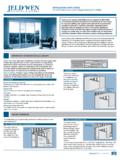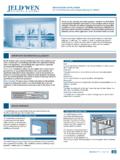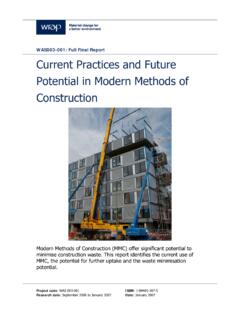Transcription of Glossary of Terms A/C A/C Condenser - 1stchoicenm.com
1 Glossary of Terms A/C: An abbreviation for air conditioner or air conditioning. A/C Condenser : The Condenser is the outside fan unit of the Air Conditioning system. It removes the heat from the Freon gas and "turns" the gas back into a liquid and pumps the liquid back to the coil in the furnace. A/C Disconnect: The main electrical ON-OFF switch near the A/C Condenser . Acrylic Knockdown (AKD): Finish applied to a concrete floor surface. Typically applied on porch floors and decking surrounding swimming pools. The concrete deck receives a textured finish. It then receives an acrylic elastic type paint or coating applied over the textured finish. It can be easily recoated or painted later which makes it appear new again. Any exterior floor area in Florida should be hosed down weekly to keep mildew at bay. Aerator: The round screened screw-on tip of a sink spout. It mixes water and air for a smooth flow. Air Conditioned Living Area: The square footage of the area that is air conditioned in a home.
2 Areas such as garage, porches, non air conditioned attic storage areas, etc. are not included in this measurement. When cost per square foot is considered the cost of the home is typically divided by the square footage of Air Conditioned Living Area. Large amounts of non air conditioned area can have a huge impact on the cost per square foot of a home. Allowances: In the specifications for the construction of a home typically numerous items are called allowances. They are typically decorator items such as cabinets, tile, wallpaper, carpet, landscaping, etc. The Builder will base the price of the home including allowances for the items agreed to as allowance items. Depending upon the choices the Buyer makes they will receive a credit if their choice is less than the allowance, none if the same as the allowance, or they will be charged the additional amount if their choice cost more than the allowance for that particular item. This is an area that allows many unscrupulous Builders to offer a below market price for a home by reducing the allowances.
3 The Buyers receive many unpleasant surprises when Builders do this throughout the process. It is not at all unusual to find out that the Builder with the higher bid has in fact the lowest cost in the end due to this practice. Protect yourself by doing some research on what you desire for the allowance items vs. the allowance offered. Amortization: A payment plan by which a loan is reduced through monthly payments of principal and interest. Annual Percentage Rate (APR): Annual cost of credit over the life of a loan, including interest, service charges, points, loan fees, mortgage insurance, and other items. Architectural Ceilings: Known as tray ceilings or other specially designed ceilings. They are typically designed by the Interior Architectural Designer and not the Architect or Designer of the home. Astragal: A molding, attached to one of a pair of swinging double doors, against which the other door strikes. Attic access: An opening that is placed in the drywalled ceiling of a home providing access to the attic Automated lighting control system: A professionally installed system that controls lights in multiple rooms without use of manual switches.
4 Backsplashes: Wall area between the cabinet countertop and the upper cabinets. This area can have tile, granite, wallpaper, or painted an accent color. Balusters: Vertical members in a railing used between a top rail and bottom rail or the stair treads. Balusters are sometimes referred to as 'pickets' or 'spindles'. Balustrade: The rail, posts and vertical balusters along the edge of a stairway or elevated walkway are known as the Balustrade. Banding: Typically refers to exterior veneer of the home. Banding is the trim installed around windows, doors, and other exterior architectural features of the home. It can be made out of stucco, wood, or stone. Bath Accessories: Includes the toilet tissue holder and towel bars. They can be metal or ceramic. Bi-fold door: Doors that are hinged in the middle for opening in a smaller area than standard swing doors. Often used for closet doors. Bi-pass doors: Doors that slide by each other and commonly used as closet doors. Bottom chord: The lower or bottom horizontal member of a truss.
5 Breaker panel: The electrical box that distributes electric power entering the home to each branch circuit (each plug and switch) and composed of circuit breakers. Builder's Risk Insurance: Insurance coverage on a construction project during construction, including extended coverage that may be added for the contract for the customer's protections. Building codes: Local and state ordinances governing the manner in which a home may be constructed or modified. Built INS: Can be anywhere in the home. The Built Ins are typically designed by the Interior Architectural Designer. They are normally built into some type of niche specially prepared for the Built in. They are highly personalized and not inexpensive. Normally, the built-ins are finished wood and include TV entertainment centers, Bookcases, Desk, Storage Chest, and much more. Bull nose (drywall): Rounded drywall corners. Caf Grille Hood: Installed on the rear porch over the outdoor grille. They should include a venting system to remove all smoke and odor to the outside through the roof or side wall of the home.
6 Cantilever: An overhang where one floor extends beyond and over a foundation wall. For example at a fireplace location or bay window cantilever. Casement: A window that one side of the window sash cranks out. Casing: The casing is the wood trim molding installed around a door or window opening. Cast Stone: Man made material to resemble coral stone or some other type of natural stone. Cast Stone is very expensive. Many times the same look can be accomplished through our stucco artists at a fraction of the cost. Cement: The gray powder that is the "glue" in concrete. Portland cement. Also, any adhesive. Ceramic tile: A man-made or machine-made clay tile used to finish a floor or wall. Generally used in bathtub and shower enclosures and on counter tops. Certificate of Occupancy: Issued by the County Building Department once the home has passed all of the required inspections by the County building department. This certificate is issued by the local municipality and is required before anyone can occupy and live within the home.
7 It is issued only after the local municipality has made all inspections and all monies and fees have been paid. CFM (cubic feet per minute): A rating that expresses the amount of air a blower or fan can move. The volume of air (measured in cubic feet) that can pass through an opening in one minute. Chair rail: Interior trim material installed about 3-4 feet up the wall, horizontally. Circuit Breaker: A device which looks like a switch and is usually located inside the electrical breaker panel or circuit breaker box. It is designed to (1) shut of the power to portions or all of the house and (2) to limit the amount of power flowing through a circuit (measured in amperes). 110 volt household circuits require a fuse or circuit breaker with a rating of 15 or a maximum of 20 amps. 220 volt circuits may be designed for higher amperage loads a hot water heater may be designed for a 30 amp load and would therefore need a 30 amp fuse or breaker. Circuit: The path of electrical flow from a power source through an outlet and back to ground.
8 CO: An abbreviation for "Certificate of Occupancy". Cold air return: The ductwork (and related grills) that carries room air back to the furnace for re-heating. Combustion air: The duct work installed to bring fresh, outside air to the furnace and/or hot water heater. Normally 2 separate supplies of air are brought in: One high and One low. Compressor: A mechanical device that pressurizes a gas in order to turn it into a liquid, thereby allowing heat to be removed or added. A compressor is the main component of conventional heat pumps and air conditioners. In an air conditioning system, the compressor normally sits outside and has a large fan (to remove heat). Concrete block: A hollow concrete 'brick' often 8" x 8" x 16" in size. Concrete: The mixture of Portland cement, sand, gravel, and water. Used to make garage and basement floors, sidewalks, patios, foundation walls, etc. It is commonly reinforced with steel rods (rebar) or wire screening (mesh). Condensate line: The copper pipe that runs from the outside air conditioning Condenser to the inside furnace (where the a/c coil is located).
9 Condensation: Beads or drops of water (and frequently frost in extremely cold weather) that accumulate on the inside of the exterior covering of a building. Use of louvers or attic ventilators will reduce moisture condensation in attics. A vapor barrier under the gypsum lath or dry wall on exposed walls will reduce condensation. Condensing unit: The outdoor component of a cooling system. It includes a compressor and condensing coil designed to give off heat. Conditions, Covenants, and Restrictions (CC and R's): The standards that define how a property may be used and the protections the developer makes for the benefit of all owners in a subdivision. Construction Agreement: The contractual agreement between the Buyers and the Builder. This agreement spells out the rights, obligations, and duties between both parties. Construction Specifications: Attached to the Construction Agreement. The specifications cannot be too long. Ours are typically 100 pages or more detailing everything we can think of that has been included with the home as well as anything that is not.
10 This is a very important document. If it is not a substantial size document be very careful. Control joint: Tooled, straight grooves made on concrete floors to "control" where the concrete should crack Convection: Currents created by heating air, which then rises and pulls cooler air behind it. Also see radiation. Cooling load: The amount of cooling required keeping a building at a specified temperature during the summer, usually 78 F, regardless of outside temperature. Corbel: The triangular, decorative and supporting member that holds a mantel or horizontal shelf. Corner bead: A strip of formed sheet metal placed on outside corners of drywall before applying drywall 'mud'. Cornice: Overhang of a pitched roof, usually consisting of a fascia board, a soffit and appropriate trim moldings. Course: A row of shingles or roll roofing running the length of the roof. Parallel layers of building materials such as bricks, or siding laid up horizontally. Deco Drain: Normally found at the intersection of the concrete rear porch and the concrete pool deck.







